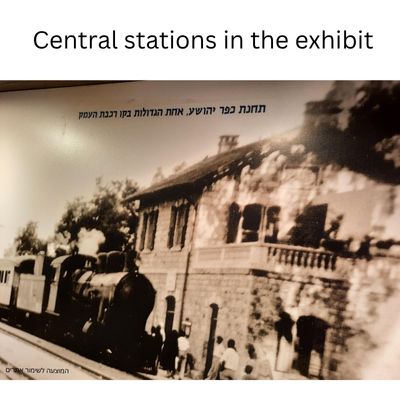אין מוצרים בסל הקניות.
Central stations in the exhibit

# Haifa East Station – This was the first train station built on this line and was the western endstation on the Haifa-Tzemach-Daraa line. It was called the Haifa Station until the British built another station in the city – the Haifa Center Station. As part of the battle against the British Mandate, members of the Etzel underground blew up the station, and the building was severely damaged. Today, the station is used for logistical purposes by Israel Railways and houses the Train Museum.
# The Kfar Yehoshua Station – or by its original name, the Tel El-Shamam station – was originally the second station on the line, after Haifa. The moshav was founded in 1927 and its residents waged a fierce campaign to change the name to the Kfar Yehoshua Station. The photo to left of the station shows the son of the bombaji, the worker responsible for filling the steam engines’ water tanks, using the water crane at the Kfar Yehoshua Station. The water crane, which stood next to the water tower, would bring water from the tank on top of the tower straight into the steam engine’s water tank.
# Afula Station – To the right of the display window is the map of Afula drawn up in 1925 by architect Richard Kauffmann, the architect of the Zionist settlement enterprise. The plan is circular, with the train station at the center. The existing train station is located outside the city.
# Beit Shean Station – To the left of the display window is a train ticket in three languages: English translated from Arabic, Arabic, and Hebrew translated from Arabic. On the other hand, the name of the station, Beit Shean, was written in Hebrew, and not Arabic in Hebrew letters, on the station’s sign, following a request by the Jewish residents.
# Nechalim Bridge Station – Named because this is the meeting point of the Jordan and Yarmouk Rivers, the name in Arabic – Jisr al-Majma’ah – means the bridge of meeting. For 43 years, it held the title of the lowest station in the world, at an altitude of minus 246 meters below sea level.
# Naharayim Station – The station is built in the international style, in contrast to the Templar style of the other stations. It was built at the request of Pinhas Rutenberg, the manager of the hydro-electric power plant at Naharayim, for use by the plant’s employees. To the left of the display window is a photo of the Yarmouk Bridge after it was blown up. In June 1946, the Palmach conducted an operation known as the “Night of the Bridges.” The Yarmouk Bridge, where the train tracks ran, was one of the bridges blown up in this operation, thereby severing the Valley Train segment from the rest of Hejaz route. The plans of the British to reconstruct the bridge were never carried out.
# Tzemach Station – This station is unique for several reasons. First, it is the only station with a double size water tower, making it possible to fill two steam engines simultaneously. Second, the station had a locomotive turntable, which made it possible for the train to change direction and drive back to Haifa. During World War I, the last cavalry battle in modern history took place at Tzemach. It was also the last battle in the British campaign to conquer Eretz Israel from the Ottoman Empire.
עוגיות
אתר זה משתמש בעוגיות כדי לשפר את הפונקציונליות של האתר, לספק לך חוויית גלישה טובה יותר ולאפשר לשותפים שלנו לפרסם לך.
מידע המפרט על השימוש בעוגיות באתר זה וכיצד ניתן לדחות אותם, ניתן לצפות במדיניות העוגיות שלנו.
על ידי שימוש באתר זה או לחיצה על "אני מסכים", אתה מסכים לשימוש בעוגיות.





